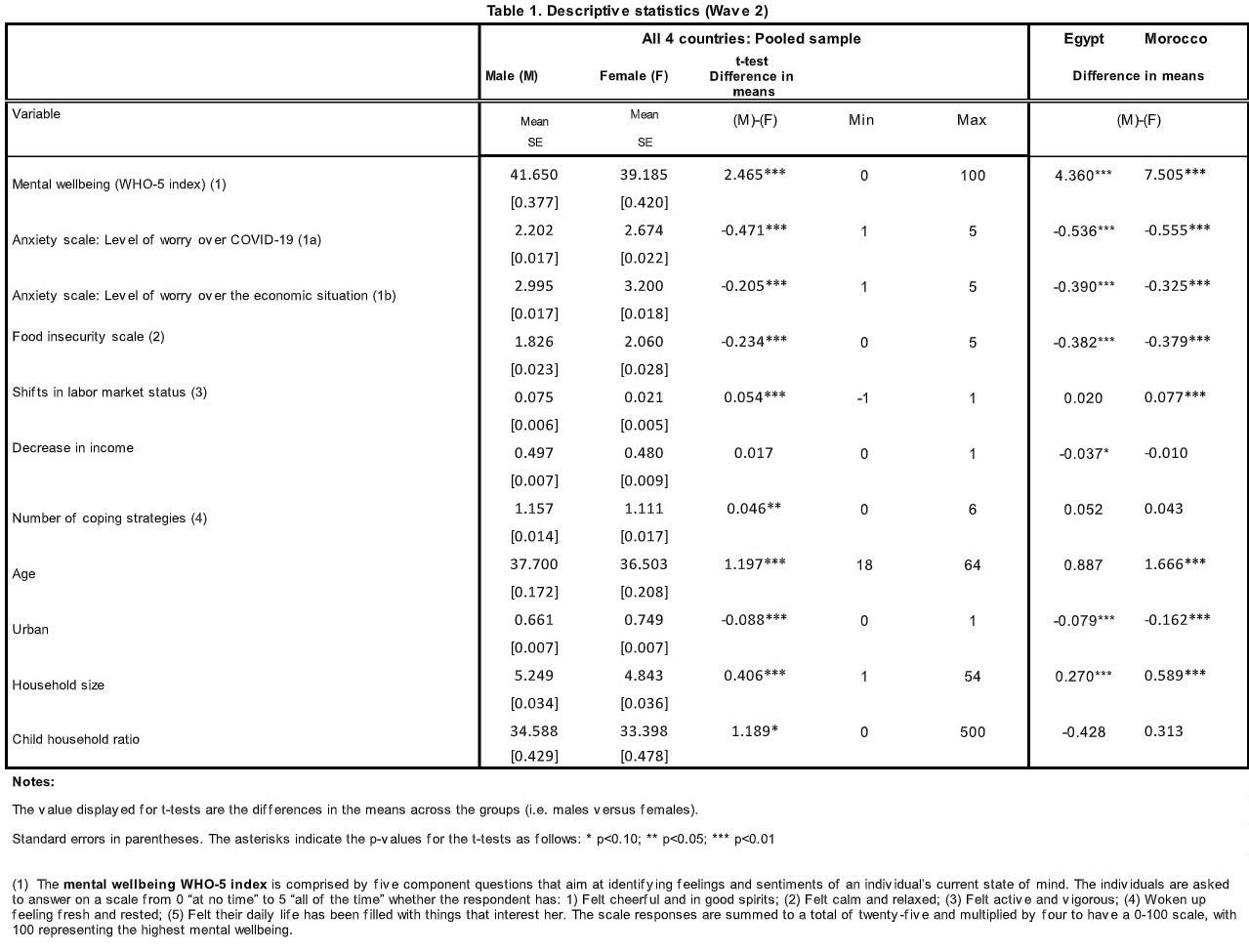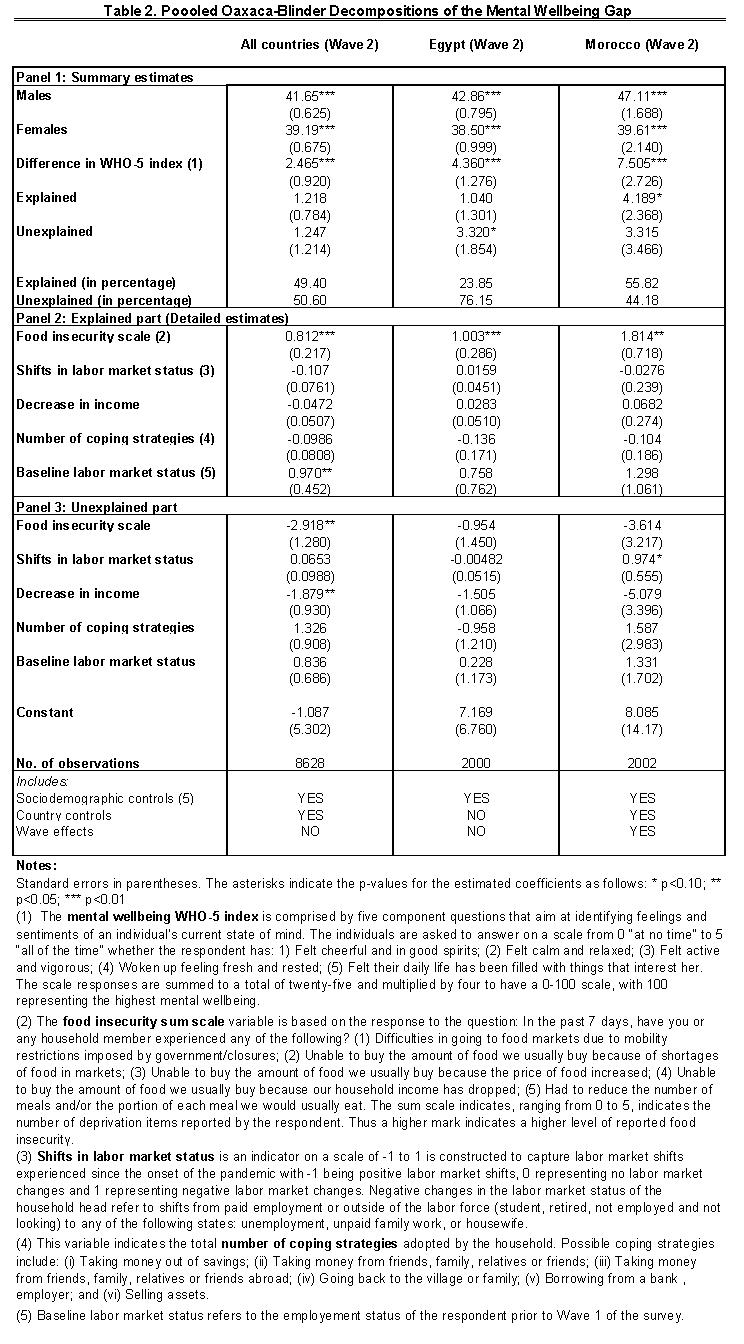
6 minute read
and Discussion
of said covariate which results from the auxiliary regressions. In other words, this denotes the extent to which the gap can be explained by differences in characteristics, and each characteristic individual - similar to the OB interpretation. Dividing each contribution �� ̂ �� by the unconditional gendered mental health gap, �� ̂ �� /�� ̂ 1 ��������������������, yields the extent to which the gendered difference of each covariate explains the total unconditional gendered mental health gap, whilst the coefficient of the group membership indicator ��1 �������������������� in the full model represent the left over unexplained gendered mental health gap.
4. Descriptive Statistics, Results and Discussion
As specified in the previous chapter, the analysis in this study focuses on the results for Wave 2 since this is the only round for which the full data sample of the 4 countries is available (in Wave 1 the data was collected for Tunisia and Morocco only). The decomposition results indicate that the gaps in mental well-being are only statistically significant in the case of Egypt and Morocco. For this reason, our main analysis is centered around the results for these two countries and for the pooled sample of the 4 countries captured in Wave 2.
Table 1 presents the descriptive statistics in Wave 2 for the pooled sample of all four countries, as well as for Egypt and Morocco alone. The statistics for the mental well-being indicator, the WHO-5 scale, indicate that for the pooled sample of all 4 countries there is a positive and statistically significant gap between men and women, with the average male mental well-being approximately 2.5 percentage points higher than that of females. In Egypt and Morocco, the gap in WHO-5 mental well-being index is also positive, significant, and considerably higher in magnitude relative to the pooled sample (4.3 percentage points in Egypt and 7.5 in Morocco). Other measures relating to the respondent’s mental state, such as the anxiety scales measuring the extent of worry over the pandemic and the household’s economic situation, confirm that men suffer less from anxiety than women; for the pooled sample and the two separate countries the mean differences between men and women are negative and statistically significant. Note that these variables are highly correlated to the mental well-being WHO-5 scale and therefore are not included as main variables of interest in the decomposition analyses.
The statistics for the food insecurity scale also portray a disadvantaged position for females. Women respondents report on average statistically significant higher levels of food insecurity than men, though the magnitude of the gap is modest, particularly in the pooled sample, (0.2 based on a 5-point scale). In Egypt and Morocco, the gap is also significant and slightly larger in magnitude (0.38 for Egypt). In terms of the employment-related factors, the variable capturing negative shifts in labor market status presents differences between men and women which are significant, though low in magnitude (0.05 for the pooled sample and as low as 0.02 for Egypt, on a scale ranging from minus 1 to 1). In this case men report slightly more negative shifts in labor market status, most likely indicating their significantly higher participation in the labor force.
Finally, several additional sociodemographic characteristics present statistically significant differences based on gender (e.g., age, urbanity, household size and child ration). These variables are thus included in the decomposition analysis as socio demographic controls.
Table 2 presents the results for the pooled OB decomposition of the mental well-being gap, the preferred specification in this study. As mentioned above, we focus on the results for Wave 2 since it is the round for which the key mental health variable was consistently available for the full sample of countries at the time of the study (column 1). Additionally, to provide some country specific insights, we present the results in Wave 2 for Egypt (column 2) and Morocco (column 3), since the mental health gap is only statistically significant in these two countries. In the case of Tunisia and Jordan the mental well-being of women is not statistically distinguishable from that of men; as such, from a statistical viewpoint, there is no significant gap to decompose.

Under the specified model, the ‘explained’ part accounts for up to 49 percent of the gap in Wave 2 for the pooled sample. In other words, nearly half of the mental health gap is explained by the differences in means of the included explanatory variables. In Egypt this explained percentage is lower (only 23 percent) while in Morocco the explained part accounts for fifty-five percent of the gap, similar in magnitude to the pooled sample.
The point estimates for each of the variables for the explained proportion of the gap are displayed in Panel 2 of Table 2. The variable which consistently yields significant coefficients is the household’s level of food insecurity. The results indicate that the difference in the extent of food scarcity in the household between the female and male respondents is correlated with the gap in mental well-being between the two genders. The positive sign and statistical significance of this result is held for the pooled sample and for the two separate countries. This result suggests that the fact that women on average report higher levels of food scarcity in their households, is correlated significantly with the finding that women suffer more from anxiety and poorer mental well-being than men. This finding is consistent with the empirical evidence showing the prevalence of disparities in food insecurity between men and women during the pandemic (Burke et al., 2020; UNWOMEN & UNESCWA, 2020; WFP Gender Office, 2020). Moreover, food insecurity has been consistently shown to be a significant negative determinant of mental well-being (Jones, 2017) and has been on the rise since the onset of the pandemic (Amare et al., 2021).
The panel at the bottom of Table 2 displays the coefficients for the variables contributing to the ‘Unexplained’ part of the mental health gap. This component captures the extent to which a difference in the ‘returns’ to each variable contributes to the gap in mental well-being. In other words, the ‘unexplained part’ indicates how, for the same mean level of a variable, the mental well-being gap is explained by the difference in the effect of each variable on mental well-being for men versus women. In the case of the variable capturing food insecurity, the unexplained part is only statistically significant for the pooled sample of countries (Table 2, Panel 3). The coefficient for the unexplained part is negative indicating that, assuming men and women reported the same level of food insecurity, the gap in mental well-being between females and males would be smaller. More intuitively, this negative sign suggests that the association of food insecurity to mental well-being is greater for men. It is plausible that the differential effect of food insecurity on the mental well-being of men and women is related to their differential roles within the household. Women may be expected to be more knowledgeable about the household’s constraints in terms of food availability and thus be better positioned to face the aliment scarcity given their much higher involvement in unpaid household labor (as documented in the literature review).
The ensemble of results for the explained and unexplained parts indicates that, for the pooled sample of countries, both components contribute to the differences in mental well-being status disfavoring women. As such, reducing the gender inequities in access to food resources could potentially reduce the inequality in mental well-being observed between the two groups.
Overall, the remaining variables included in the analysis do not yield robust significant results for the explained part of the model. The only exception is the variable capturing baseline labor market status. In particular, the results for the pooled sample indicate that men on average exhibit higher labor market status and that this is associated with the observed gap in mental well-being between the groups.


